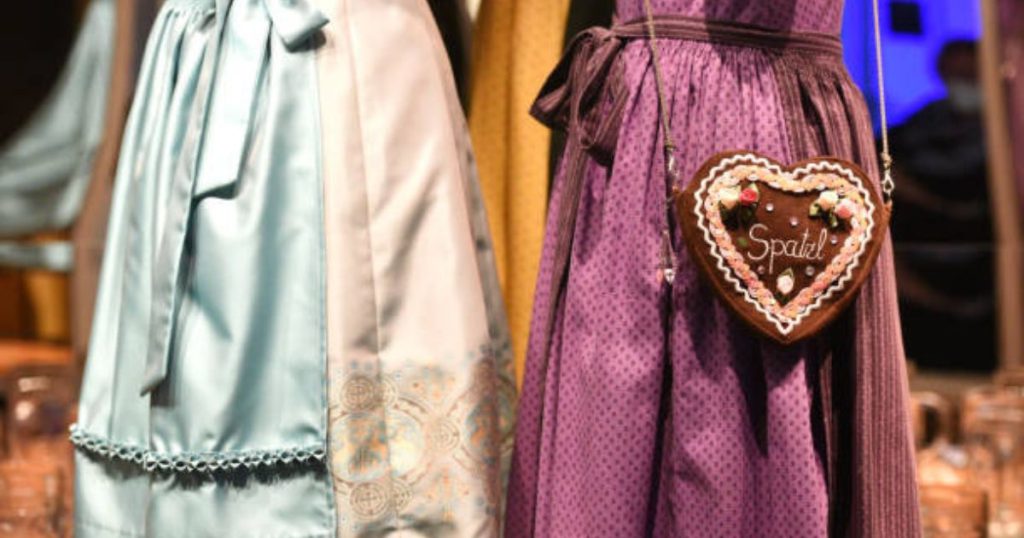Dirndl Dress
Dirndl 101: Everything You Need to Know About this Classic German Dress
Dirndl 101: Everything You Need to Know About this Classic German Dress
Never wear a Dirndl, the traditional dress of Germany. There are a few things you should be aware of. However, we do appreciate that not everyone wears a dirndl once or twice a week as we do. This is a simple method to putting on your Rare Dirndl and getting ready for Oktoberfest!
- #1 Undies: Use a supportive bra. It doesn’t have to be a push-up bra but it must position the ladies correctly.
- #2 Bloomers: These are a smart choice if you intend to get your polka on. Although not everyone will be peering up your skirt, there will undoubtedly be some curious eyes and some judgemental Omas should your skirt blow off. It is better to be safe than sorry.
- #3 Blouse: The next step is the blouse, which may be the traditional off-the-shoulder, full puff-sleeve sweetheart blouse or our most recent invention, the roulette. (Do be sure to take advantage of this step, please!) Most Rare Dirndl blouses are made of a 65% cotton/35% polyester blend, which is fantastic since it allows easy washing and drying. We advise using the gentle cycle while washing them. The draped sleeve blouses should be air-dried, but the off-the-shoulder blouses may be dried in the dryer (although I accidentally dried one on high, and it was alright). Lace tops are more fragile and must be handled with extra care. Air drying after hand washing or on a gentle cycle in the washing machine is recommended. Bleach can be very damaging to the fabric. At your own risk, use. We advise using distilled white vinegar and an oxygen-based stain lifter as an alternative.
- #4 Dirndl: The central front of most rare dirndls has a zipper, so pull it over your head or into it if your floor is “nice and putz” and zip that baby up. There may be some sucking in involved, but a beautiful tight fit is preferable to a loose-fitting dirndl.
- #5 Lace-Up Front: If your dirndl has a lace-up front, you may probably locate the appropriate ribbon and chain in the pocket (yes, there is a pocket!) The ribbon or chain should be threaded through the hooks at the top, crisscrossed as it descends, and tied in a bow (or knot if it’s a chain) at the base.
- #6 The Apron: The apron completes the look (unless your dirndl comes with a belt, in which case, just put on the belt). At the natural waist, the apron is knotted to conceal the seam. Either bring the ties around the front and knot a bow there or tie the apron in a bow in the back. If you are single, place the bow on the left side; if you are married, place the bow on the right side.
Dirndl aprons frequently become stained first. Most Rare Dirndl aprons may be machine washed, but always read the care label first. Lace aprons that are more delicate are now quite popular and must be hand-washed or spot cleaned. Aprons with beaded lace should be placed flat to dry.
- #7 Accessories: Add your jewelry, tights, or socks to complete the appearance.
- If it’s cold, carry an Edelweiss Hair Clip Sweater.
- A hot dude in Lederhosen with a beer stein, of course!
- There you have it, then. The fundamental instructions for donning your dirndl. Stop reading this and have fun by posting images of yourself wearing your ultra-chic dirndl on Facebook or Instagram with the hashtag #RareDirndl! It’s a fact that girls with dirndls are more fun!
How To Clean Your Dirndl
Your dirndl will look its finest after being dry or spot cleaned with a damp cloth and detergent. The dirndls are often made of machine-washable materials.
Pro Tip: Nonetheless, the exquisite handiwork is the main factor keeping you from washing it. The front hooks and hardware might corrode, and the trim could tear. When bringing your dirndl to the cleaners, always empty your pockets and leave your chain and ribbons at home. Everyday Dirndls are made specifically to be machine washable. You may also wash other dirndls in the washing machine on a gentle cycle, including the Small Black Dirndl. Line drying is preferred to machine drying.
Ironing Your Dirndl: Best Practices
The most important thing to remember while ironing is that synthetic fibers, such as polyester, can melt if the iron’s temperature is too high. Cotton is suitable for high-heat ironing. Use your iron gauge to assist you in choosing the heat setting; a melted dirndl is preferable to higher heat. You may email us or take your dirndl to the cleaners and ask them for advice if you have any questions about caring for it. Instead, hug Oma and give her the item; she’ll likely take care of it for you.

